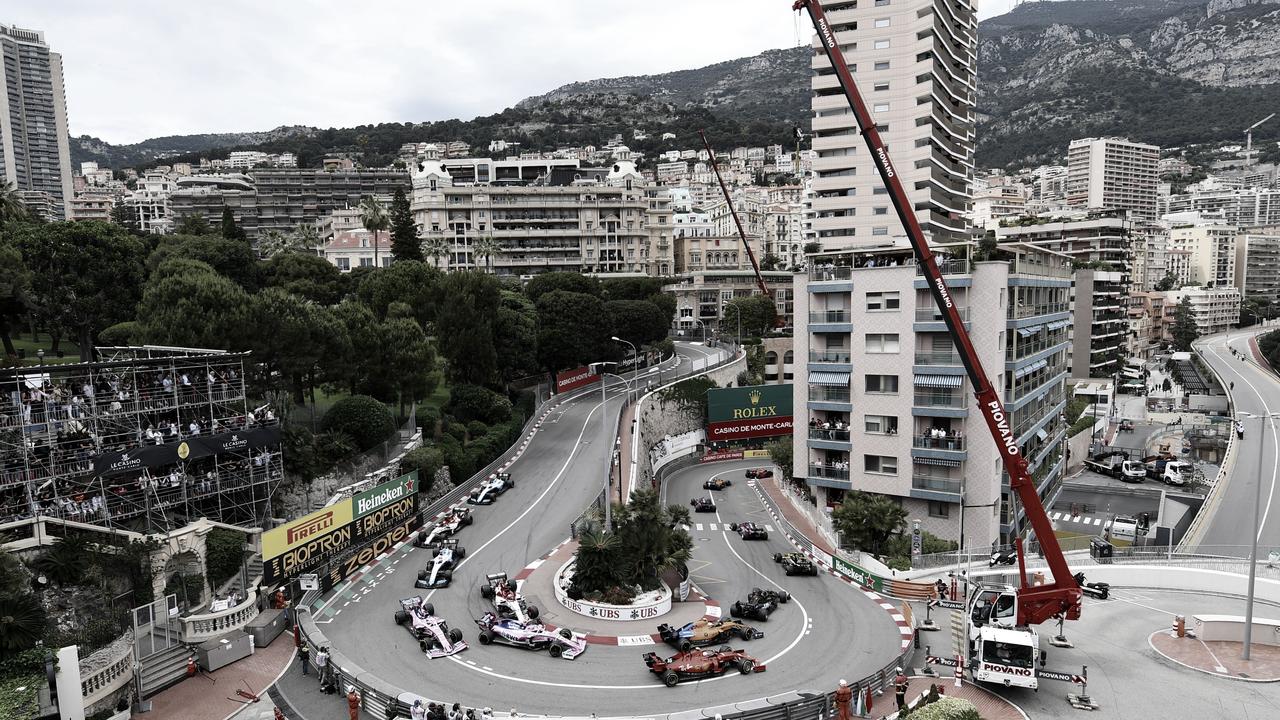Once the brilliant and glittering jewel in the Formula 1 crown, the Monaco Grand Prix now looks dull and lifeless.
Monte Carlo has for so long been the centrepiece of grand prix racing and one of the few events to transcend motorsport. Only so many punters could identify Le Mans or the Indianapolis Motor Speedway on sight, but Monaco is motor racing to the minds of so many.
Ironically there’s little racing to be had on those serpentine streets these days.
Every qualifying session and race from the 2024 FIA Formula One World Championship™ LIVE in 4K. New to Kayo? Start Your Free Trial Today >
Saturday qualifying remains one of the sport’s great feature events. To watch the fury of a Formula 1 car surging between the barriers, dancing in the millimetres that separate peril from pole position, offers an unparalleled insight into the bravery and skill that separates the legends from mortals.
But for years the Sunday spectacle at motorsport’s most famous race has been in severe decline, with Formula 1 outgrowing its best known venue little by little every year.
The nadir is surely this year’s race, the most straightforward in F1 history.
For the first time ever, the top 10 drivers finished a grand prix in exactly the same position they started.
This was no fluke, with the official lap chart showing not a single position change in the top 10 for the entire 78-lap slog.
A confluence of factors ensured the snooze-fest, but those varied reasons had been building for years. Bad luck brought them together at the weekend, but it’s not for misfortune alone that the 70th running of the world championship Monaco Grand Prix will go down as one of its most lamentable spectacles, Charles Leclerc’s glorious victory aside.
Meanwhile Formula 1’s calendar is bursting at the seams with statement races in global cities. Melbourne is an always popular destination. Singapore is long established as Asia’s glamorous Monaco analogue. F1 has tipped hundreds of millions of dollars into getting Las Vegas off the ground. A Madrid street race will make its debut in 2026.
And is it a coincidence that F1 top brass chose this weekend to reveal it’s talking to organisers in Thailand, South Korea and Indonesia about new street races?
With just one race remaining on Monaco’s current contract, something has to give.
‘Why did he try to attack me?!’ | 00:52
WHAT’S THE PROBLEM?
Put simply, size matters.
For decades Formula 1 cars have become engorged while Monaco’s streets have remained as sinewy as ever.
Consider the dimensions of the modern F1 car.
Leclerc’s Monaco-winning Ferrari measures 5.63 metres long and 2 metres wide, and it weighs a whopping 798 kilograms. With refuelling banned, F1 cars in 2024 can tip the scales at a titanic 908 kilos on the grid.
The 2024 F1 car has a slightly larger footprint than a Range Rover, which sizes up at 5.25 metres long and 2.05 metres wide.
Around 30 years ago an F1 car measured a petite 3.5 metres by 1.6 metres and weighed 595 kilograms. Overtaking has never been easy in Monte Carlo, but you can understand why it’s become practically impossible.
But size isn’t the only contributing factor.
Overtaking has become more difficult as car performance has improved.
Speeds have increased but braking distances have shortened, greatly reducing the margin in which drivers can duel for track position.
Pit stops have shortened dramatically and rarely go meaningfully wrong, leaving less room for tactics.
And whereas once greater unreliability would randomise results, the rock-solid endurance of the modern car means a driver is almost certain to see the chequered flag if they can keep out of the walls.
Pirelli’s tyres don’t help, though it’s no fault of the manufacturer. Pirelli must manufacture five compounds to work across all 24 tracks. Monaco is the most extreme among them, generating the lowest energy of any circuit, and thus drivers were able to complete 77 of 78 laps on either the hard or the medium compound, albeit at a markedly reduced pace, killing all strategy.
The problems are easy to identify. The solutions aren’t so simple.
‘It’s alright mate, I’m in charge here’ | 00:35
NEW CARS WON’T SAVE THE DAY
Reducing car size is easier said than done.
The cars have ballooned incrementally over the decades, mostly for safety. Stronger cars inevitably means heavier and larger cars.
The hybrid power unit also hasn’t helped, coming in at around 55 kilograms heavier than the previous naturally aspirated V8s.
Shrinking the cars back down to the size of decades past is impossible, but even small gains aren’t easy.
Though the 2026 regulations haven’t been published yet, the FIA intends for cars that are 15 centimetres shorter, 10 centimetres narrower and 50 kilograms lighter — a start but not a game-changer.
There’s early talk — only talk — that the following set of rules in 2030 could see a return to lighter naturally aspirated engines. Further weight savings on the chassis might also be possible.
That all means we’re looking at half a decade at a minimum before we might start to see meaningful size and weight reduction.
And even then so many of the other problems remain —short braking zones, improved reliability, pit stop efficiency. Slightly smaller cars and somewhat lighter cars will be no panacea.
TRACK CHANGES ARE NO GUARANTEE OF BETTER RACING
Track changes are annually raised as a possible solution to Monaco’s overtaking crisis, with Christian Horner a regular advocate roadworks.
“We should always be open to where we can improve,” said the Red Bull Racing team boss. “We either need to make the cars considerably smaller going forward for 2026, which isn’t really on the cards, or to have a really entertaining race here then we ought to look at least the possibility of [opening] up some areas that could potentially create at least an overtaking opportunity.
“To protect the next 70 years here, I think that there needs to obviously be some evolution.”
But it’s not as if it hasn’t been considered before.
In 2021 Ross Brawn, then the F1 managing director, said the sport had been there and done that.
“We’ll take a look, but it won’t be the first time someone has taken a look at doing something like that,” he admitted. “No-one has come up with a solution so far.
“We do have tools now — we have built our overtaking simulation tool and we will certainly have our people take a look at it — but it’s pretty challenging.”
It’s not as though there’s much land to use anyway. Monaco is the world’s second-smallest state, spanning just 2.08 square kilometres. Only Vatican City is smaller.
There’s almost no chance of substantive changes that would really shake things up. The track is truly embedded in the city, so much so that at some corners the barriers are pressed right up against historical buildings. With the harbour on one side and the rising topography of the city on the other, there are precious few usable alternative routes.
Even if one could be found, the only guaranteed way to generate action is to implement a long DRS straight leading into a big braking zone — exactly the same sort of layout used at practically every new racetrack.
And would that that be a meaningful solution? DRS passes are almost never memorable and are rarely exciting. Bumping up the overtake count with a swag of push-to-pass overtakes would create an artificial spectacle at best.
You’d also be sacrificing the one thing Monaco has that no other circuit does: history. Is that really worth a few cheap passes?
Lap 1 disaster for Perez at Monaco GP | 02:09
FORMAT CHANGES COULD BOOST MONACO’S STRENGTHS
Without substantive and destructive changes to the cars or the circuit, Formula 1 must use the levers that are readily available to it, like format changes and sporting regulation tweaks.
It’s here that it might find some solutions that preserve and even enhance Monaco’s place in the F1 landscape.
“They can definitely come out with a specific weekend for this particular weekend,” Lewis Hamilton insisted. “They should come up with some new formula for it rather than it just be the same.
“I would say maybe special tyres for this race, so you have more pit stops that create more variability.”
Enforcing more pit stops could create more strategic variability, though inevitably teams conclude on the same strategic approach that minimises time in pit lane and overall race time, taking us back to square one.
“They just find tactics to overcome it, so I don’t think tyres or strategy is going to make a lot of difference,” Brawn said.
Daniel Ricciardo suggested instead that qualifying, the undoubted highlight of the weekend, could be given greater prominence.
“It should just be like a three-day time trial,” he said. “The track’s open for three days straight, nine hours a day, and you just pick when the temperature is right and you try to set it up.
“Maybe that would make it different and interesting [and] make the Sunday a bit more interesting.”
It’s an impractical solution but a useful starting point.
Like the Indianapolis 500, which holds a similar level of esteem for IndyCar, Formula 1 should be unafraid to single out Monaco for its own bespoke weekend format.
A simple tweak would be enough to create significantly more spectacle. After running the weekend as normal up to Saturday night, Sunday morning could start with single-lap qualifying. Only the drivers who progressed to Q3 the day before would take part, and they would run in the reverse order of Saturday’s results.
Such a format would tick several boxes.
It would enhance the qualifying spectacle by opening a new battleground.
It would give Monaco a unique selling proposition that embellishes its appeal.
It would also guarantee Sunday would generate talking points regardless of the quality of the race.
It wouldn’t solve overtaking difficulties, but it would enhance what’s already great about the weekend without damaging the event’s DNA.
It wouldn’t satisfy everyone, but then no solution to this interminable problem ever could.
RED FLAGS MUST BE UPDATED
Finally, while not specific to the Monaco Grand Prix, the weekend’s turgid race was a reminder that the rules around red flags and tyre usage need urgent review.
Currently all changes are allowed under reds so long as they can be undertaken in the fast lane of the pit lane. That includes making the mandatory switch of tyre compounds.
Some have grumbled about this rule before, but in years past it was simply luck of the draw. Red flags were so rare that teams and drivers simply had to cop that luck hadn’t gone their way.
But red flags have been allowed to proliferate in recent seasons to avoid race laps being soaked up behind the safety car — a sensible decision for sport and show.
But if F1 is going to use red flags so liberally, the rules need to be updated to ensure they’re not entirely jeopardy free.
Unlimited repairs should be allowed, but tyre changes made under the red flag shouldn’t satisfy the mandatory compound change.
That ensures that teams and drivers can still take advantage of stoppages without them totally disrupting the narrative of the race.
Such a rule would have prevented almost every driver completing practically the entire race without a live pit stop, having changed their tyres during the red flag.
It would have preserved the strategic jeopardy on which so much of the Monaco spectacle hangs.
Formula 1 should also consider ways to facilitate Pirelli developing a special Monaco tyre compound that’s soft enough to generate similar strategic variability as at other races, though admittedly it would be a difficult request given Monte Carlo’s unique demands would be difficult to replicate at a test circuit.
Monaco deserves its place on the calendar for its history, prestige and pure driving challenge. Some small tweaks — quick, simple and reversible — can ensure Monte Carlo remains sustainable in modern Formula 1.







